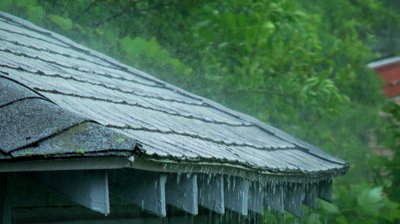
The Anatomy of a Leaky Roof
The Anatomy of a Leaky Roof
Roof leaks can develop for a number of reasons, such as wind damage, poor insulation, lack of maintenance and insufficient flashings around chimneys, vents, skylights or gutters. Age is often a factor too as most roofs need to be replaced every twenty to thirty years. On average homeowners spend about 1 to 4 percent of a home’s value yearly on maintenance and repairs such as gutter repairs, roof repairs and much more. A $200,000 home on average receives at least $2,000 in repairs annually according to choice home warranty.
“Water is probably the single most destructive force to a house,” said inspector Jeff Del Guercio, owner of An Objective Inspection in Throop, Pa., and president of the local National Association of Home Inspectors chapter. “And a leak can go on for a long time without being noticed.”
When every 1000 square foot of roof surface experiences a rainfall of 1″ you can expect 600 gallons of roof run-off water. That’s a lot of water for just 1″ of rainfall!
Most homes have twice that much roof surface area.
A 3000 square foot roof surface experiencing 25″ of rainfall would have approximately 45,000 gallons of water running off from the roof each year.
The reality is that most homes with 3 bedrooms, 2 bathrooms and an attached garage have more than 3000 square feet of roof surface and experience more than 25″ of rainfall. Therefore, a tremendous amount of moisture can seep through a hole in the shingles or around poor or old rusted flashings. A leaking roof can and often does mean rotting sheathing and rafters. Larger amounts can soak the insulation in the attic and eventually the ceilings and walls. Interior moisture in ceilings and walls generally creates mold which can become a very serious health issue.
If not properly controlled it’s a huge amount of water seeping under your house.
Why Flashing is so Important
Flashing is a vital part of the roof structure when it comes to leaks. The most difficult element to control is water and roof flashing acts like the last line of defense against water. Roof flashing is usually a sheet of metal, which is placed over joints in the roof and wall construction to prevent water seeping into the house and causing damage.
The major cause of residential roof leaks is a fault in the roof flashing. Roof flashing represents a very simple and intuitive engineering technique that has been known for hundreds of years. The whole idea depends almost entirely on gravity. If the flashing has been installed correctly, gravity will work with the flashing material to shed the water onto the regular roofing materials, where it is then directed harmlessly to the ground.
Flashing is placed around projections in your roof, like skylights, venting units, parapets, hatches and chimneys. It is also placed in the valleys of your roof, where two elevations of your roof make contact.
Flashings are the most technical and most difficult aspect of roofing in most cases. Failure of the flashing system is usually a major cause of roof deterioration.
Traditional roof flashing methods and materials stand the test of time, but they must be installed correctly by an experienced and skilled technician.
Flashing installation and repairs must be done by knowledgeable roofing technicians like the technicians at Sunrise Roofing & Chimney.
Beware of leaking over your electrical wiring
As ironic as it may sound, water can be a big fire hazard in most homes. Once water starts to leak into the framework of a house, it can easily seep into wires located in an attic or ceilings. Many electrical wiring shorts, arcs and other failures can be directly traced to a leaky roof.
Always take the proper precautions when dealing with roofing leaks seeing as they can cause everything from health issues to the possibility of fire or a collapsed roof and everything in between.